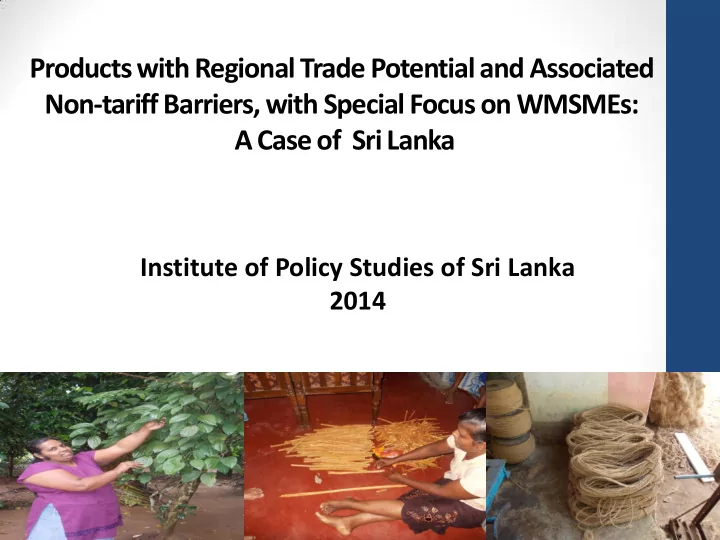

Products with Regional Trade Potential and Associated Non-tariff Barriers, with Special Focus on WMSMEs: A Case of Sri Lanka Institute of Policy Studies of Sri Lanka 2014
Outline • Objectives • Background • Methodology • Preliminary Findings • Barriers Identified • Recommendations
Objectives 1) Identify constraints faced by WMSMEs in SL in operating & expanding business including issues related to accessing regional markets: NTBs/ trade facilitation linked barriers 2) Provide policy & programme recommendations to ease/manage the constraints
Background SMEs in Sri Lanka • No clear definition of SMEs in SL • In Sri Lanka SMEs account for: • 80 -90 % of the total number of enterprises in Sri Lanka • Contribute 30 % in terms of value addition • Account for 32.7 % of the employment from Agricultural sector, 26.3 % of the employment from Industrial sector 41.0 % of the employment from Services sector -(NEDA, 2009)
Background Women and MSMEs • Women labour force participation in SL is one of the lowest in the region (30 %) • Women participation can be increased – attract more into labour force (employees) & encourage women to be entrepreneurs (employers) • Only 8.8% of the firms in the country have a ‘Female Top Manager’ & only 26.1% of the firms with female participation in ownership. (The World Bank, 2011) • Gender biasness against women is common in the SME sector (The National Policy on Human Resource and Employment) • Majority are micro-enterprises that operate informally & they tend to be grouped in particular sectors such as food processing & textile (Staermose, 2009)
Background Sri La’s Trade with SAARC - 2013 12,000 25,000 10,000 20,000 8,000 US$ Million US$ million 15,000 6,000 10,000 4,000 5,000 2,000 - - World Exports SAARC Exports World Imports SAARC Imports
Background Top 10 SAARC Exports and Imports - 2013 Exports Imports Pepper, pepper and capsicum Petroleum oils, not crude Cements, portland, aluminous, slag, super Cruise ship, cargo ship, barges sulfate & similar hydraulic Medicament mixtures (not 3002, 3005, 3006), Insulated wire/cable put in dosage Woven cotton fabrics, 85% or more cotton, Animal feed preparations, nes weight over 200 g/m2 Cloves (whole fruit, cloves and stems) Cars (including Station Wagon) Woven cotton fabrics, 85% or more cotton, Cane or beet sugar and chemically pure weight over 200 g/m2 sucrose, in solid form Waste and scrap of paper or paperboard Motorcycles, side-cars Trucks, motor vehicles for the transport of Natural rubber, balata, gutta-percha etc. goods Fibre-board of wood or other ligneous Fabrics, knitted or crocheted, of a width of > 30 materials cm (excluding warp knit fabrics) Other nuts, fresh or dried, whether or not Cotton yarn (not sewing thread) 85% or more shelled cotton, not retail
Methodology Overview of Research Design
Methodology Product Selection Stage 1: Consultation with National Enterprise Development Authority (NEDA) • Handloom • Crushed & reed products • Coir Based Products • Spices • Cut Flowers/ Foliage • Kithul Trickle • Processed food (Jam, cordials, dehydrated fruits) • Handicrafts (coconut shell based, wood based, Palmyra) • Ornamental fish
Methodology Cont. Product Selection Stage 2: HS Code Product Description Current Exports to Indicative Potential Indicative Potential SA (US$) to Export to SA (US$) to Export to SA (%) 0904 Pepper & Capsicum 43,104,000 27,361,000 38.83 0907 Cloves 12,659,000 5,676,000 30.96 0906 Cinnamon 3,586,000 3,207,000 47.21 5702 Coir floor coverings 30,000 504,000 94.38 5308 Coir Yarn 354,000 226,000 38.97 Source: Trademap
Methodology Cont. • Stage 3: • Advisory Committee Consultation • Composed of: • National Enterprise Development Authority (NEDA) • Export Development Board • Department of Export Agriculture • Chamber of Small and Medium Industries of Sri Lanka • The Spice Council of Sri Lanka • The Ceylon Coir Fiber Exporters’ Association • Women's Chamber of Commerce • UNDP
Methodology Product Selection Spices (Pepper, Cloves and Cinnamon) & Coir (Coir Floor Coverings & Coir Yarn ) • High trade potential to SA • High involvement of women
Methodology Cont. Site Selection • Spices • Matale- Pepper • Kegalle- Cloves • Ahungalle- Cinnamon • Galle- Cinnamon • Coir • Kurunegala • Galle • Batticaloa
Preliminary Findings • Women are highly concentrated at the lowest level of value chains • Higher levels of the value chains are mainly male-dominated • Poor bargaining power of women at the lowest level of value chains (price/ quality) • No specific buyers • Poor/Lack of understanding of their own potentials & capabilities • Poor/Lack of understanding of market potentials (clove, pepper)
Preliminary Findings Cont. • Poor knowledge on product quality standards (cinnamon, coir) • Difficulties in meeting required quality standards (cinnamon, clove) • Mostly home-based • Limited investment capacity of MSME • Most of the Micro/small level producers are not satisfied with the price they get for their product • Most MSMEs are not direct exporters but market through intermediaries
Barriers Identified • Information Gap • Market information: Price, Buyers, Input suppliers, Value-chain • Available services: Financial and Non-financial • Poor Networking • No/limited trade related associations • No/limited women membership/ participation in trade related associations • Limited participation in trainings & skill development programmes • Due to time constraints and family obligations • Difficulties in handling certain activities of the production process for women • Social Concerns • Poor recognition (cinnamon) • Low interest among the younger generation (coir)
Recommendations Policy • Government involvement in determining prices. • Government approved/operated collecting centers. • Introduce unique quality standards for products. Programme • Awareness Creation (market information, available services). • Establishing trade-related associations/ co-operatives at village level for women.
Thank You www.ips.lk
Recommend
More recommend